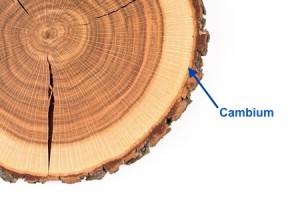Initials carved into a tree five feet off the ground will remain five feet off the ground regardless of how tall the tree grows. Trees don’t grow from their base, they grow from their tips. We call this plant tissue an apical meristem. A typical oak tree in Hampton Roads has primary meristems, where the tree elongates and grows taller, and a secondary meristem where the tree adds girth. This secondary meristem is called the cambium, and is located in a thin layer of cells just under the bark and wrapped around the circumference of the stem. You can think of the cambium as a delicate, thin cone, wide at the tree’s base and narrowing as you move upwards.
The Cambium

Radial Cross Section Showing Cambium Location
This secondary meristem, or cambium, allows a tree to grow fatter, and differentiates a tree from a herbaceous plant that lacks this ability to increase in girth. The cambium is usually only a few cells thick and is directly responsible for installing the tree’s “plumbing” or vascular system. The cambium produces the phloem to the outside, pipes that transport the trees food, and the xylem to the inside, pipes that transport water and essential elements from the roots to the crown.
Here an important point can be made. When you understand a tree’s critical vascular system is located just below the bark, you can improve your care of trees. It becomes immediately obvious how a tree can be severely injured when the bark is knocked off and the thin, fragile cambium destroyed. It is equally obvious that tree climbers who wear spikes when climbing trees for pruning are puncturing the cambium repeatedly, perhaps hundreds of times.
Trees Wounds Never Heal
When a tree is damaged, it never repairs the damaged tissue. That tissue is forever lost for storage and transportation of water, nutrients, and sugars. This point bears repeating, trees do not heal, they attempt to seal or compartmentalize wounds. The implications of this fact of tree biology is important for proper tree care. If a tree is pruned three times over a ten year period, and a climber, wearing spikes, takes a hundred “steps” for each pruning, the tree will have three hundred permanent wounds. Those injuries will remain for the life of the tree. When tree injuries occur, pathogens are always nearby, waiting for an opportunity. Fungal spores, viruses, and bacteria are perpetually present, and if given an opportunity to infect a tree, they will seize it.
Trees grow taller in a race with other trees to capture sunlight and transform the sun’s energy into tree food. Their expanding girth provides enough structural support to reach heights necessary in the battle for sunlight against the ever present competition. They have evolved these growth strategies over millions of years. By understanding how trees grow, we can care for them properly and treat them, not as lifeless telephone poles, by as living associates that provide oxygen and shade and countless other wonderful ecological benefits.
